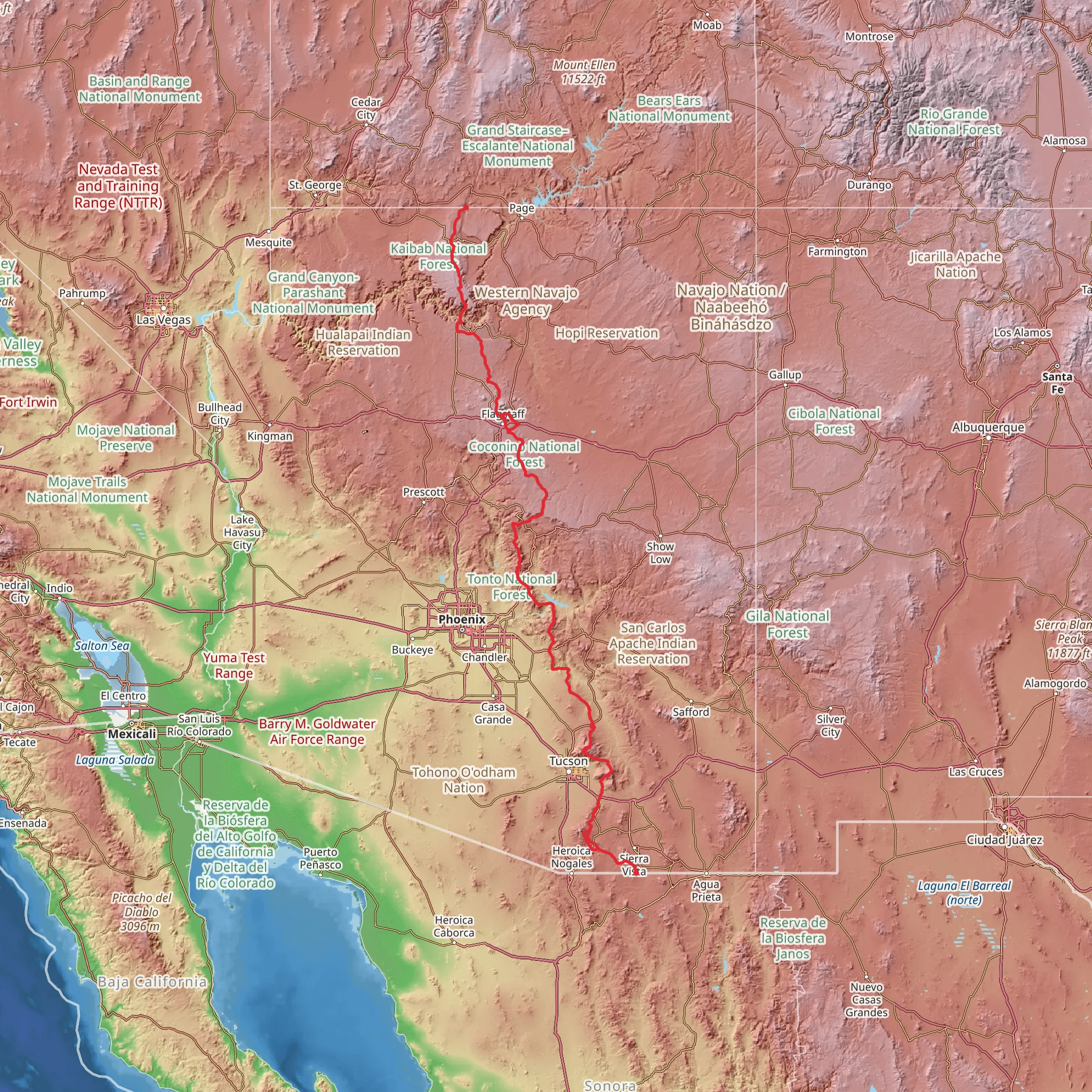Download
Preview
Add to list
More
1265.0 km
~73 days
46765 m
Multi-Day
The Arizona Trail is an iconic long-distance trail stretching approximately 1265 kilometers (786 miles) from the state's southern border with Mexico to the northern border with Utah. With an elevation gain of around 46,700 meters (153,200 feet), the trail traverses a diverse array of landscapes, offering hikers a unique cross-section of Arizona's natural beauty.
Getting to the Trailhead
The southern terminus of the Arizona Trail is located near Cochise County, close to the US-Mexico border. To reach the starting point by car, hikers can drive to Montezuma Pass, which is accessible via Coronado Memorial Road near the town of Sierra Vista. For those relying on public transportation, options are limited, but shuttle services may be available from larger cities like Tucson to Sierra Vista, where hikers can then arrange for a taxi or local shuttle to Montezuma Pass.
Trail Overview
The trail is classified as a point-to-point hike and is estimated to have a medium difficulty rating. It is recommended that hikers plan their journey carefully, considering the length and elevation changes. The use of a navigation tool like HiiKER can be invaluable for planning and staying on track.
Notable Sections and Landmarks
As you embark on the Arizona Trail, you'll encounter a variety of ecosystems, from desert scrub and grasslands to alpine forests and mountain ranges. The trail is divided into 43 passages, each with its own unique characteristics and challenges.
- Huachuca Mountains: The trail begins with a climb through the Huachuca Mountains, offering stunning views of the surrounding desert. This section includes Miller Peak, one of the highest in the range, with an elevation of 2,888 meters (9,475 feet).
- Santa Rita Mountains: Further north, the trail winds through the Santa Rita Mountains, where hikers can witness the impressive sight of Mount Wrightson, the highest peak in the range at 2,882 meters (9,453 feet).
- Saguaro National Park: One of the trail's highlights is the passage through Saguaro National Park, where the iconic saguaro cacti stand tall against the backdrop of the Rincon Mountains.
- Mogollon Rim: As the trail progresses, hikers will traverse the Mogollon Rim, a significant geological feature that presents a dramatic escarpment marking the southern edge of the Colorado Plateau.
- San Francisco Peaks: Near Flagstaff, the trail skirts the base of the San Francisco Peaks, the remnants of an ancient stratovolcano. Humphreys Peak, the highest in Arizona at 3,851 meters (12,633 feet), dominates the skyline.
- Grand Canyon: Perhaps the most awe-inspiring section is the passage through the Grand Canyon. Hikers will descend into the canyon, cross the Colorado River, and climb back out, experiencing one of the world's most magnificent natural wonders.
Wildlife and Flora
The Arizona Trail offers an opportunity to see a wide range of wildlife, including mule deer, elk, black bears, and even mountain lions. Birdwatchers will be delighted by the variety of bird species, especially in riparian areas. The flora is equally diverse, with different plant communities corresponding to the varying elevations and climates along the trail.
Historical Significance
The trail passes through regions rich in history, from ancient Native American sites to remnants of old mining towns. The Arizona Trail also intersects with the historic Mormon Pioneer Trail and the Grand Canyon, which holds cultural significance for several Native American tribes and is a UNESCO World Heritage Site.
Preparation and Planning
Given the trail's length and diverse conditions, hikers should prepare for a variety of weather and terrain. Water sources can be scarce, especially in the desert sections, so careful planning for water and resupply is crucial. It is advisable to check the Arizona Trail Association's website for current trail conditions and water reports.
Seasonal Considerations
The best times to hike the Arizona Trail are in the spring (March to May) and fall (October to November) to avoid the extreme heat of the Arizona summer and the snow in the higher elevations during winter. However, due to the trail's length and varied elevations, hikers may still encounter snow and hot temperatures during these windows.
By taking the time to understand the trail's challenges and wonders, hikers can embark on a memorable journey through the heart of Arizona's diverse landscapes.
What to expect?
Activity types
Comments and Reviews
User comments, reviews and discussions about the Arizona Trail, Arizona.
4.83
average rating out of 5
6 rating(s)

